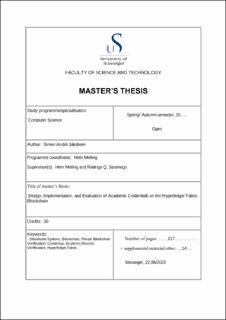| dc.contributor.advisor | Meling, Hein | |
| dc.contributor.advisor | Saramago, Rodrigo | |
| dc.contributor.author | Jakobsen, Simen André | |
| dc.date.accessioned | 2020-09-27T18:42:46Z | |
| dc.date.available | 2020-09-27T18:42:46Z | |
| dc.date.issued | 2020-06 | |
| dc.identifier.uri | https://hdl.handle.net/11250/2679790 | |
| dc.description | Master's thesis in Computer Science | en_US |
| dc.description.abstract | Hyperledger Fabric is a novel blockchain technology platform that is modular and adaptable in terms of applying it to use-cases: The architecture is modular, which makes it accommodate a variety of use cases such as consensus, privacy, and memberships. The smart contract is adaptable to the architecture too, making the data-modeling very flexible. The benefit of this framework relies on its ability to remain private by both separating and merging transaction ledgers from di erent network participants. Furthermore, we aim to create a solution for verifying academic records in a decentralized manner. With the use of blockchain technology for use cases like this, we establish a new way of gaining trust, transparency, and accountability for those entities that issue academic records. Though not as transparent as permissionless blockchain systems, we seek to see the benefits of choosing a system like Fabric over systems such as Ethereum. Our smart contracts are designed to be modular and has support for the modularity of the architecture in Hyperledger Fabric. Nevertheless, the modularity comes at a cost of an increased amount of configuration required to make the network work. We share some of our experiences on how working with Hyperledger Fabric is like, which we believe is important for future decisions to decide to use Fabric or not. Moreover, we attempt to address this by assessing di erent common issues with frameworks like these - namely, the configuration needed to provision blockchain systems to those who want to adopt it. However, we also experiment with the framework where we measure the impact of the di erent features of the Fabric chaincode package, and how they a ect the execution times. | en_US |
| dc.language.iso | eng | en_US |
| dc.publisher | University of Stavanger, Norway | en_US |
| dc.relation.ispartofseries | Masteroppgave/UIS-TN-IDE/2020; | |
| dc.subject | informasjonsteknologi | en_US |
| dc.subject | datateknikk | en_US |
| dc.title | Design, Implementation, and Evaluation of Academic Credentials on the Hyperledger Fabric Blockchain | en_US |
| dc.type | Master thesis | en_US |
| dc.subject.nsi | VDP::Teknologi: 500::Informasjons- og kommunikasjonsteknologi: 550 | en_US |
